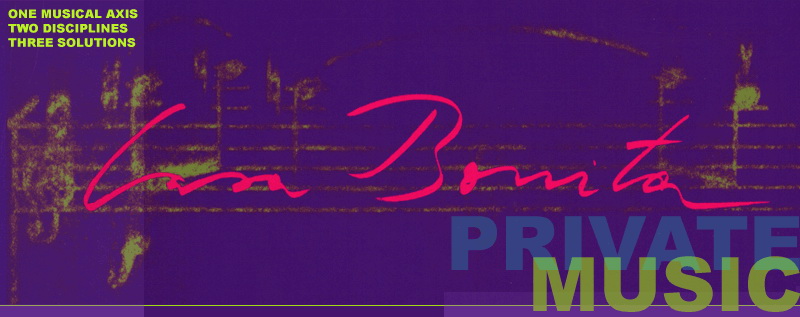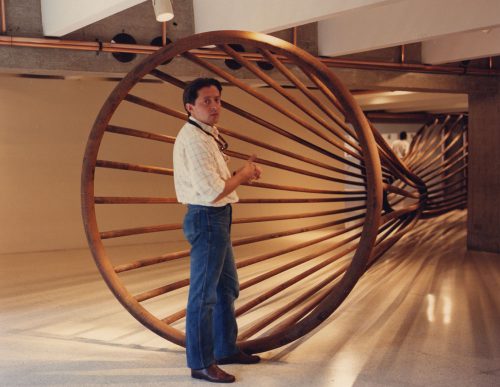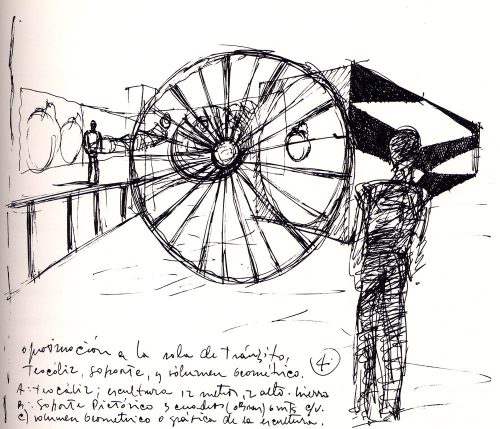From the very first four-hand session by artist and composer, they were bound together by the Fibonacci numbers, a constant in the individual creations of each. They quickly agreed on a bar as the space to be created in the Ideal House, where the musical macroformat Del paraíso would flow. The Bar would be the place to promote a feeling of gaiety while, at the same time, transmitting the idea of a possible model of the universe. The environment is created in the circular diorama, set up as a reversible space, where the two edges of the painted horizon are joined and inverted, creating a virtual orbital cylinder where the law of gravity is defeated. What prevails in Pizzani’s work is the line of a horizon that seems to swirl continuously around the dislocated spectator, who is doubly stimulated with Marturet’s continuously flowing digital keyboard music.
Based on these ideas, Jorge Pizzani developed the Double Chalice with painted canvases surrounding the walls in the room. The Double Chalice is a synthesis of the figurations found in his latest pictorial works – as his first notion of an Absolute Object where double constitutive concepts are joined: mystical (the union of heaven and earth) and physical (the state where there is neither space nor time). The Double Chalice intercepts the spectator in the entry hall to the Bar, vibrating continuously with the series of progressive numbers that make it up, in the exact center where all the music of Casa Bonita flows together.
The musical titles are personal codes or subjective references having to do with the writing of each piece. Marturet says, “Many of them popped into my mind as I composed the piece, tying it in with the artist for whom it was being written. That is what happened with many of the titles in Bar celestial. They are also reflections of attitudes towards the modern-day night world: Amazonas de Neón speaks of a new type of woman who, I feel, exists in Venezuela and unfolds with night life. There are three movements in this piece: K. bellos sintéticos, Noche de los ochenta and Bye Bye. Love Song for my Answering Machine (Canción de amor para mi constestadora automática) includes voices, distorted by the synthesizer, and consists of messages I have received on my answering machine. It also tells a bar story: a man who, in the middle of a night on the town imagines for a moment that he is at death’s door. He’s a city dweller, a slave to modern life. Suddenly, in his reverie, he realizes that up in Heaven he will no longer have his answering machine, an essential and perfect part of his modern life, the “perfect secretary,” who asks no questions and keeps all secrets. Appalled at the idea, he writes a love song to his answering machine. It is a very strange piece, that uses elements that are totally unconventional from the standpoint of normal musical guidelines. The same is true of Febrero 30 that tells the story of a sort of gnome or elf who spends all his time searching the calendar for February 30 as the doorway to travel in time. It, too, is a work with many layers of information mixed together… There is a story behind each one of the pieces, but I don’t know if you are trying to tell me that the audience may not understand the music if they know nothing about it.”
The work is the conclusion of intense communication between the composer and the artist, and both ideas worked off of each other, until they achieved a space that summarized the neurotic, schizoid, altered atmosphere of modern-day bars, without losing sight of the good time and relaxation for which they are also known… “From my very first encounter with Eduardo Marturet’s work,” Pizzani says, “a creative dialogue sprouted up between us…And, perhaps because of the empathy between us and the fun and festive relationship between Eduardo and myself, I was offered the Bar: a place of recreation and neuroses, of social intercourse and cordiality.… My Bar has complete images and, somehow, contains the principle of the universe: it is a bar of knowledge, of leisure time, of recreation, of anguish… That is why I chose the shape of a double chalice, a double wineglass, as a parabolic image synthesizing the ‘Chalice of God’: Theochalice. It is there that the three rooms of music come together, the journey through the exhibit begins, and the metaphors that Marturet presents in his piece Paradise merge.”
DEL PARAISO
Click on the streaming audio links below to sample.
- Nostalgia de Plomo
- Requiem de Juguete
- Rocky-Fire
- Acid Garden
- Las Amazonas de Neon (A W.A. Y H.B.)
- 1. Noche de los Ochenta
- 2. K. Bellos Sinteticos
- 3. Bye, Bye, Bye
- Love Song A Mi Contestadora Automatica (34')
-
Merengue Japones (21')
O La Influencia del zen en la Cocina Celestial - Glue for a Broken Heart
- LLuvia Paciente Locura
- Cocktail de Nubes (55')
- Febrero 30: Opera en al Acto! (34')
- Casa Bonita


